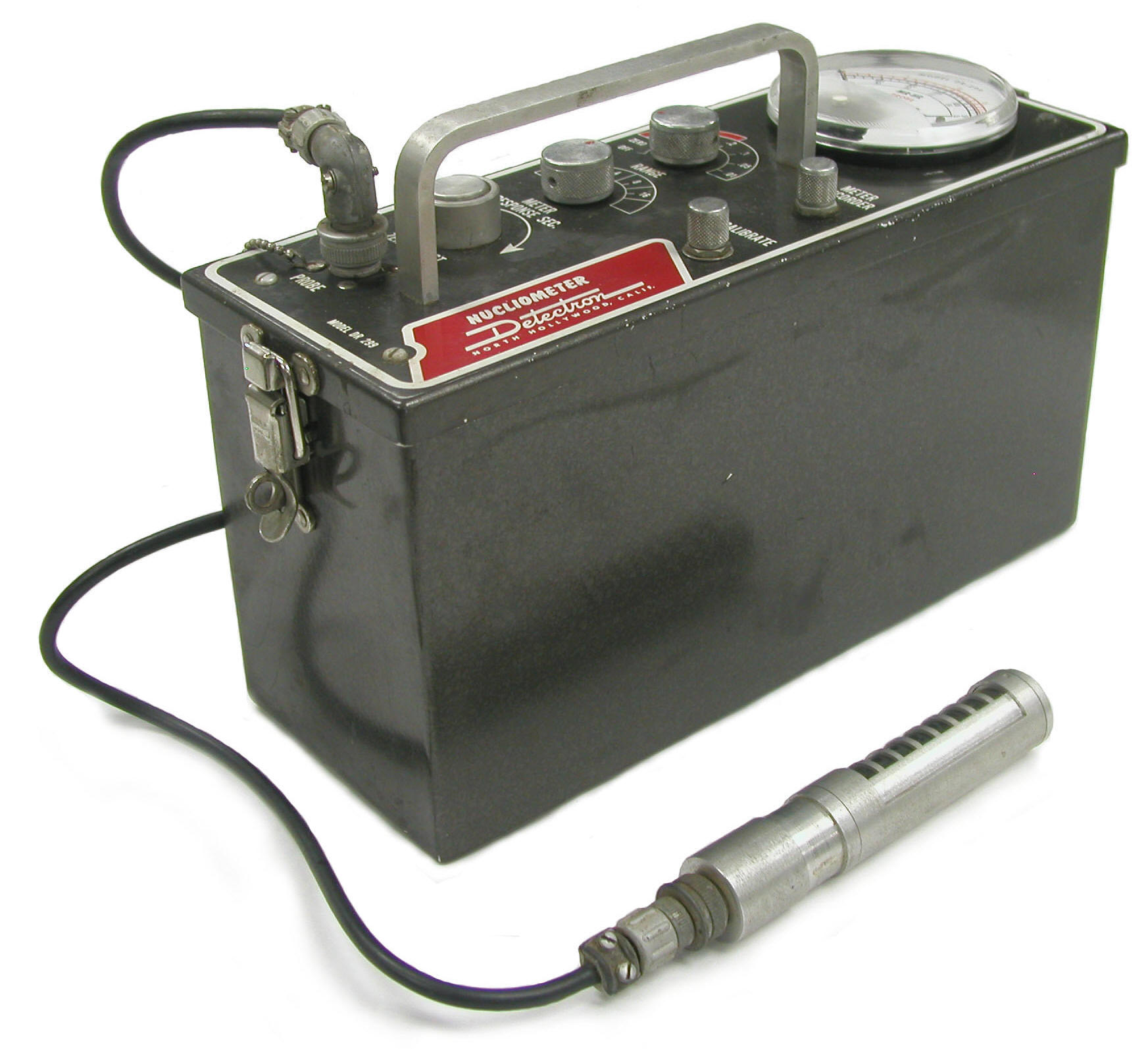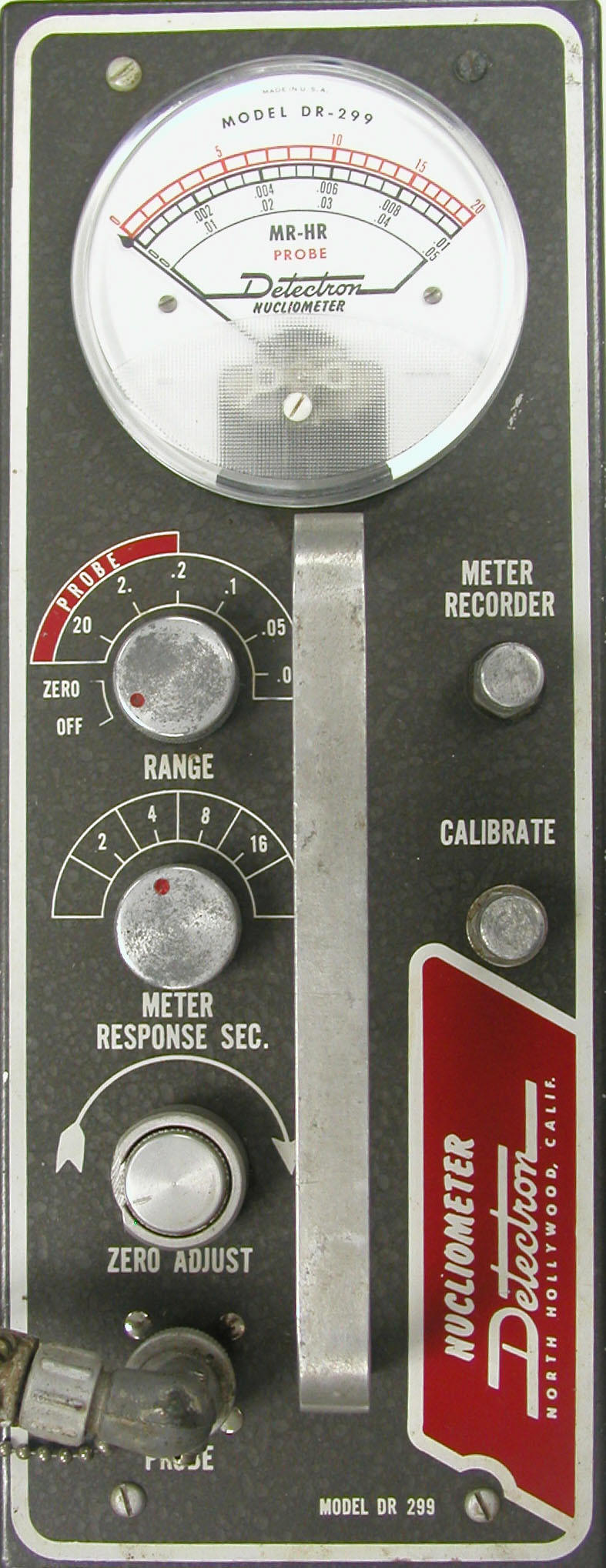Detectron Nucliometer Model DR-299 Geiger Mueller Survey Meter (ca. 1955)

The Model DR-299 Nucliometer was a "high end" GM survey meter produced by the Detectron Corporation of North Hollywood, California.
To obtain maximum sensitivity, the Nucliometer had 24 thin-walled GM tubes (you read that right, 24 of them) inside the case. There was one more GM tube in the external probe.
Despite Detectron's claim that the instrument was rugged, almost all the tubes are collapsed in every Model 299 you encounter today. The customer service folks at Detectron must have had their hands full when the company started to market this thing.

View one of these collapsed tubes.
Quoting the company's description of the DR-299: "one of the most versatile of all uranium prospecting instruments, the Nucliometer is responsible for many of the best uranium discoveries. It has detected many deposits previously missed by other, less sensitive instruments. The DR-299 can be used for ordinary prospecting, to check individual specimens, to make field assay estimations, in grid map survey work and in airborne survey work. In short, there is no application in which the DR-299 is not suitable. Not only is the Nucliometer versatile, but it is also extremely reliable. The instrument, unlike all scintillation counters, is not affected by heat and vibration, yet has extreme sensitivity to radiation."
So highly did the company think of this instrument that they referred to it as the "greatest advancement in uranium detection in years."
The photograph below shows the inside of the unit. The ends of the 24 GM tubes can be seen in the bottom of the case. Trust me, they are all collapsed. The two sets of "B" batteries can also be seen, but the three 1.5 volt D cells are missing.

The Model 299A (not in the ORAU collection) was designed for airborne surveys. It came with an external meter that could be connected to the instrument via a ten-foot cable. This allowed the pilot to make readings in the cockpit while the instrument was located in the plane's luggage compartment. If the detector was in the cockpit, there could be a high background if the plane had any any radioluminescent dials.
The Model 390-B Nucliometer (not in the ORAU collection) was also intended for airborne surveys. The main difference was that the 390-B came with 24 Victoreen 6306 bismuth-lined GM tubes. The 24 tubes in the Model 299 and 299A Nucliometers were a mix 6306 and less sensitive 1B85 tubes.
Detector: Thin-wall GM tubes—19 Victoreen 1B85 tubes (1 in the external probe and 18 inside the case) and six Victoreen 6306 tubes
Range: Instrument: 0-0.01, 0-0.05, and 0-0.1 mR/h
Probe: 0.2, 0-2, 0-20 mR/hr
Audio: No speaker but connections for headphones
Size: ca. 12" x 5" x 7"
Weight: ca. 9.5 lbs
Batteries: One 67.5 volt "B" (Eveready No.467), three 30 volt "B" (Eveready No. 413), three 1.5 volt "A" (standard D cells)
Price: $545
Since Detectron was located in North Hollywood, it was only natural that their instruments were used in a number of motion pictures, e.g., The Brain from Planet Arous. In fact, Larry Cassingham, the company president, served as the Technical Director for a number of films, e.g., Zombies from the Stratosphere with Leonard Nimoy and The Atomic Kid starring Mickey Rooney.
References
- Advertisement. Pioneer Industries Inc. Nevada State Journal. Feb. 20, 1955.
- Detectron Flyer. Sensational New Nucliometer. No date.
- Detectron. Prospectors Manual. Copyright date 1956.
